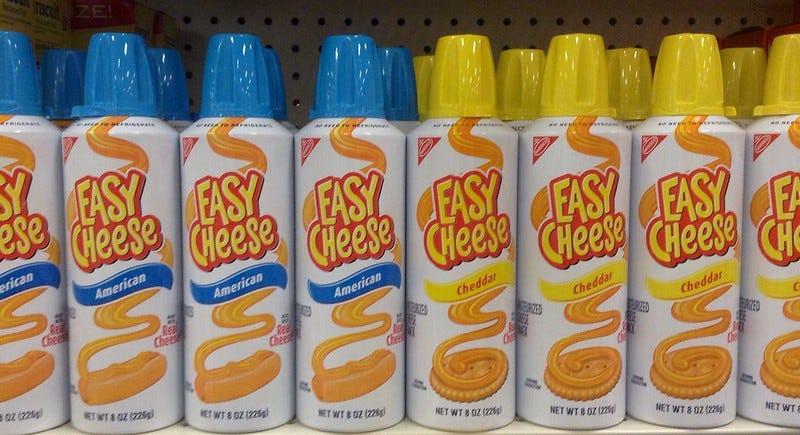Paid subscribers, your contribution lets me pay writers $1/word. Thank you! (If you haven’t yet supported Smart Mouth and its writers, please subscribe here).
New Episode: Bakery Boxes with Kristina Cho
Chinese baking is both ancient and brand-new. And those pink pastry boxes? They're from the 1970s. Even if you remember it differently.
Listen to Smart Mouth: iTunes • Google Podcasts • Stitcher • Spotify • RadioPublic • TuneIn • Libsyn

Pass the Canned Cheese, Please
Back in the late ’90s, my grandmother used to feed me Ritz crackers and Easy Cheese as an after-school snack. You know, “spray cheese from the famous family of aerosol cheeses,” according to Vince Vaughn.
Now, cheese in a can has basically fallen off the radar as an actual food. Ingredients like sorbic acid, sodium alginate, and apocarotenal, whatever that is, aren't that appetizing. But canned cheese didn't always have a bad rep.
Kraft Foods founder James Kraft created the OG processed cheese in 1915. He packaged it in tins to send overseas to the troops in WWI. Next came Velveeta, invented in 1918 by Swiss-born Emil Frey, who had set out to repurpose waste created by cheesemaking. By adding whey, the liquid released by curds during the process, to leftover cheese, he created a product that was supremely meltable. Kraft scooped up Frey’s Velveeta Cheese Company in 1927.
In 1952, Kraft changed snack history again with the launch of Cheez Whiz in a jar. Made of “reprocessed cheeses,” it was a timesaver for busy homemakers. No slicing or grating required! Promotional booklets demonstrated its diversity as an hors d'oeuvre (spread on tiny bread rounds and topped with an olive), sandwich condiment, and even a waffle topper.
Not to be outdone, competitor Nabisco released a cheese spread called Snack Mate (that became Easy Cheese) in 1965. Magically packed inside a can, it was a game changer. One only had to push a nozzle to release a glorious twirl of the stuff to decorate crackers, boiled eggs, celery, and more. With no knife or spoon required, the “instant cheese for instant parties,” as it was marketed, was an overnight success. Smithsonian’s National Museum of American History in Washington, D.C., has a display dedicated to snack engineering that glorifies the invention.
Commercials in the ’80s further exalted canonized processed cheese as an essential part of celebrations. “The nicest gifts under the tree are the ones you make yourself,” said one Christmastime Kraft ad, highlighting a festive sandwich tray made with Velveeta slices, rolled ham, and margarine.
The advent of “clean” eating that took hold in the 2010s pushed processed anything out of favor, exalting farm-fresh cheese and plant-based “cheeze” made with cashews (… also a processed food) as the superior choices. Yet for devoted fans (Kate Winslet included), processed cheese still holds a special place in our hearts, on supermarket shelves and atop Ritz crackers — no refrigeration required. 🧀
More Food Media:
I was on a Food52 podcast! We talked about the best cookies I’ve ever eaten, and how sexy mayonnaise is.
“They’re showing that an ube snickerdoodle or a black sesame muffin is as American as any apple pie.” These articles are important, but they bum me out hugely, as they show that too many Americans are living small lives. (And I don’t have that snickerdoodle.) (This also relates to this week’s podcast.)
On ending hunger: “Lo and behold, if you give people money, they are less poor.”
OK this isn’t about food, but I’m interested in domestic culture and anthropology overall, and I encourage you to be, too.
If you enjoy the newsletter today, please forward it to someone who’d enjoy it, and tap the heart icon above or below, which will help me reach more readers. I appreciate your help, y’all!
This newsletter is edited by Katherine Spiers, host of the podcast Smart Mouth.
A TableCakes Production.
Want to contribute? Here are the submission guidelines.




